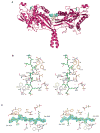The structure of the kinesin-1 motor-tail complex reveals the mechanism of autoinhibition
- PMID: 21836017
- PMCID: PMC3339660
- DOI: 10.1126/science.1204824
The structure of the kinesin-1 motor-tail complex reveals the mechanism of autoinhibition
Abstract
When not transporting cargo, kinesin-1 is autoinhibited by binding of a tail region to the motor domains, but the mechanism of inhibition is unclear. We report the crystal structure of a motor domain dimer in complex with its tail domain at 2.2 angstroms and compare it with a structure of the motor domain alone at 2.7 angstroms. These structures indicate that neither an induced conformational change nor steric blocking is the cause of inhibition. Instead, the tail cross-links the motor domains at a second position, in addition to the coiled coil. This "double lockdown," by cross-linking at two positions, prevents the movement of the motor domains that is needed to undock the neck linker and release adenosine diphosphate. This autoinhibition mechanism could extend to some other kinesins.
Figures



References
Publication types
MeSH terms
Substances
Associated data
- Actions
- Actions
Grants and funding
LinkOut - more resources
Full Text Sources
Other Literature Sources
Molecular Biology Databases

